RNZAF 75 Sqn Overseas Deployment
RNZAF 75 Sqn overseas deployment for Ex Vanguard 84, and Ex Cope Thunder 84-7 13 Aug 84 to 25 Sep 84 – written in 2024 by (then) Wg Cdr Jim Barclay, CO 75 Sqn
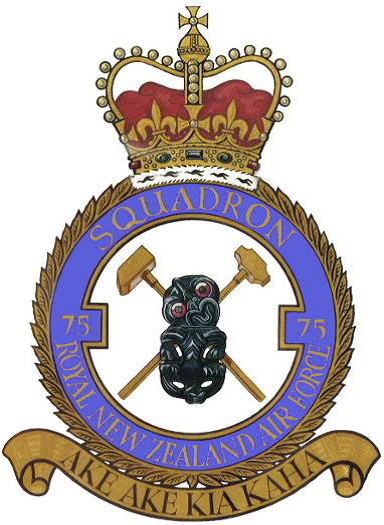
From the mid-1950s with leased Royal Air Force (RAF) Vampires and Venom aircraft, and then with leased Canberra B2 aircraft from 1958 until 1962, New Zealand maintained an offensive air force element in Singapore. In 1962 the Canberras were returned to the RAF, and No 75 Squadron (Sqn) RNZAF was relocated to New Zealand. Thereafter, an offensive air element of 14 Sqn RNZAF Canberra B (i) 12s until 1970, and with 75 Sqn A4K Skyhawks from 1971, were deployed on an annual basis to SE Asia from New Zealand to operate in theatre for short periods – these deployments were named Exercise (Ex) Vanguard.
The deployment to Singapore by 75 Sqn in 1984 was named Ex Vanguard 84 (the 29th Vanguard), and it was followed by redeployment to the Philippines to participate in Ex Cope Thunder 84-7. The 75 Sqn Unit History sheets, now with the Air Force Museum at Wigram, have been a very useful reference in compiling this narrative.
The Singapore and Philippines deployment
In total some 120 75 Sqn personnel and supplementary trade specialist ‘loanbacks’ were involved in the 1984 deployment to Singapore and the Philippines. I held a briefing in the Base Theatrette at RNZAF Base Ohakea for all these 75 Sqn people in the week preceding the deployment.
I also held a crew briefing on Sunday 12 Aug 84 at 1600 hours for aircrew of all aircraft involved with the deployment to Singapore; there were eight Skyhawks, one P3B Orion (captain Flt Lt Peter Douglas) and three C130H Hercules involved. Also an RNZAF Andover positioned a mobile TACAN navigation aid (navaid) at Bali International Airport for use by the Skyhawks. In addition to the normal crew aboard the P3B were the Deployment Commander, Ohakea Base Commander and former C0 75 Sqn Gp Capt Stewart Boys AFC, and two A4 pilots, Flt Lt Ross Drysdale and Fg Off Dave Barham, who had ready access to the USN Natops Flight manual in case of an A4 inflight emergency.
The formation callsigns, pilots, and Skyhawk serial numbers for the trip to Singapore were as follows:
Kiwi Red Wg Cdr Jim Barclay A4K NZ6201
Fg Off Mark Tapp A4K NZ6203
Fg Off Mark Wingrove A4K NZ6204
Kiwi Gold Sqn Ldr John Bates AFC A4K NZ6208
Flt Lt Dave Brown A4K NZ6209
Flt Lt Mark Helliwell A4K NZ6210
Kiwi Amber Maj John Davis USAF, and Plt Off Nick Osborne TA4K NZ6262
Flt Lt Stu McKenzie, and Plt Off John Benfell TA4K NZ6254
The three C130s were named Support 1 to Support 3. The two A4 pilots unlucky not to fly an A4, or travel in the P3, to Singapore travelled aboard one of the Support C130s – the ‘spare’ A4 pilots were Flt Lt Ian Walls and Fg Off Trev Marsh whose turn came later.
Flying to Singapore 13-15 Aug 84
Day 1 – The first C130, Support 1, was airborne from Ohakea at 0530 hours on Monday 13 Aug 84 to fly to RAAF Richmond (near Sydney, NSW, Australia) – on board were key 75 Sqn groundcrew whose role was to receive the A4s on arrival at Richmond, carry out any rectification needed on the A4s, refuel the aircraft and ‘dispatch’ them to RAAF Townsville.
At 0830, the P3B was airborne from Ohakea aiming to be positioned about mid-Tasman Sea as the A4s passed overhead enroute to Richmond. The role of the P3B was to provide navigation assistance and enroute radio communications to Oceanic Air Traffic Control as the A4s had only shorter range VHF and UHF radios, but not long range HF.
At 0900 in Skyhawk A4K NZ6201 I led Kiwi Red on takeoff from Ohakea bound for Richmond, taking 3.1 hours for the 1241nm/2299km flight across the Tasman Sea. Kiwi Gold and Kiwi Amber formations followed at 5 minute intervals respectively for their trans-Taman flights. The two TA4Ks were air-to-air refuelled at Top of Climb by two Skyhawk ‘tanker’ aircraft flown by Flt Lt Garry Rasmussen and Wg Cdr John Lanham.
At 0930 Support 2 C130 departed Ohakea bound directly to RAAF Townsville with more 75 Sqn groundcrew to receive the A4s and refuel them in the same manner as did Support 1 at Richmond.
The P3B remained with the A4s until they had established radio contact with Sydney Air Traffic Control, whereupon the P3 flew directly to RAAF Base Townsville where it remained overnight.
After a refuel at Richmond, I flew A4K NZ6201 to RAAF Townsville, as 1 of 4, in 2.3 hours for the 1109nm/2055km flight.
If I recall correctly, Support 3 C130 departed Ohakea a day later with the remainder of the 75 Sqn personnel, plus A4 spare parts, bound for an overnight stopover enroute before flying on to Singapore.
Day 2 – After an overnight stay at Richmond, Support 1 ‘leap-frogged’ on to RAAF Darwin to be in position for the arrival of the A4s. And after an overnight stay at Townsville (and a most enjoyable meal at our favourite Mariner’s Seafood restaurant), I flew A4K NZ6201 on Tuesday 14 Aug 84 from Townsville to RAAF Darwin, as 1 of 4, in 2.5 hours for the 1007nm/1866km flight. Having dispatched the A4s from Townsville, Support 2 joined us for the overnight stay at Darwin.
Day 3 – after an overnight stay in Darwin, the final two legs were flown from Darwin to Singapore on Wednesday 15 Aug 84; Support 1 departed first for Bali International Airport in Indonesia so as to be ready to receive and refuel the A4s. The P3B departed Darwin next, followed by the eight A4s as Kiwi Red, Gold and Amber. Having dispatched the A4s from Darwin, Support 2 flew directly to Singapore.
After a 2.3 hour flight to cover the 955nm/1769km distance to from Darwin to Bali I landed at Bali as flight leader of Kiwi Red. The P3B remained airborne at altitude over Bali until the eight A4s had been refuelled before the P3 set heading from Bali to be about midway along the track to Singapore as the A4s passed by.
I then led the A4s to RSAF Paya Lebar in Singapore, a distance of 904nm /1676km taking 2.1 hours. After dispatching the A4s from Bali, Support 1 followed on to Paya Lebar and thus was the final act of a finely tuned operation to get eight A4s and some 120 personnel safely positioned in Singapore and ready for Ex Vanguard 84.
Ex Vanguard 84 (#29), RSAF Paya Lebar, Singapore
Six ‘area familiarisation’ flights were flown by 75 Sqn on Thursday 16 Aug 84. On Friday 17 Aug 84 I flew A4K NZ6204 on an ‘Area Famil Navex’, as 1 of 2, from RSAF Paya Lebar to RMAF Butterworth, then to RMAF Kuantan on the east coast of Malaysia, before flying back to Paya Lebar for a GCA approach – all this in 2.1 hours and doing circuits at each of the three airfields.
Integrated Air Defence System (IADS) Air Defence Exercise (ADEX) 84
Wikipedia tells us, “Formed on 1 Nov 71, the Five Power Defence Arrangements (FPDA) are a series of bilateral defence relationships established by a series of multi-lateral agreements between Australia, Malaysia, New Zealand, Singapore, and the United Kingdom, all of which are Commonwealth members that once belonged to the British Empire.”
Amongst other ground and naval force FPDA exercises, from time to time the FPDA members agreed to stage an air defence exercise (ADEX) to test the response from the respective Air Defence centres in Singapore and Malaysia. FPDA Exercises were organised and planned by the Headquarters of the Integrated Air Defence System (IADS) based at RMAF Butterworth, Malaysia. Normally, airspace was ‘closed’ to all civilian air traffic for blocks of several hours on each day of the exercise. In the 1970s and 1980s ‘attacking’ aircraft flew assigned tracks at assigned altitudes against assigned targets in Singapore and Malaysia that in turn were defended by RSAF Hawker Hunter, RSAF F5E Freedom Fighter and RAAF Dassault Mirage III fighters in Singapore, and by RMAF F5 and RAAF Mirages at Butterworth. Variations to the central theme of each IADS exercise were developed over the years, but with the RNZAF’s 75 Sqn always being assigned the ‘canned’ attacking role, with very little freedom to manoeuvre, I felt there was seldom much to be gained from these ADEXs to enhance our operational training and readiness.
I flew four missions on FPDA/IADS ADEX 84 – I don’t remember details of these flights and my Pilots Logbook merely records the essentials. But, we typically flew from Singapore at some 26,000 feet to ‘attack’ RMAF Butterworth from below 8,000 feet agl having joined with Butterworth-based RAAF Mirage escorts, and/or carry out an ‘attack’ on RMAF Kuantan, and then a final ‘attack’ from some 13,000 to 20,000 feet on return to Singapore. If we saw fighter interceptors closing on our formation I think were allowed to do only a 90 degree defensive turn before resuming our original flight path. The four ADEX missions I flew were as follows:
On Monday 20 Aug 84 I flew A4K NZ6203 Mission 652, as 1 of 2, for 1.3 hours
On Tuesday 21 Aug 84 I flew A4K NZ6210 Mission 650, as 1 of 2, for 1.8 hours
On Wednesday 22 Aug 84 I flew TA4K NZ6254 Mission 665, as 2 of 2, with passenger Captain Foo, OC RSAF 13 (T33) Sqn, for 1.5 hours – and my aircraft sustained a cracked windscreen from a mistake I made. By now I had accumulated 4128 total flying hours, 906 of which were in the Skyhawk – so experienced pilots do make mistakes, too. I recall a little of how this unfortunate event happened: – we took off from Paya Lebar, crossed the Straits of Johore and flew at lower level northwards over Malaysian jungle before we encountered a heavy localised rain shower. As I moved to close formation on my flight leader I switched on the ‘Rain Removal’ system that in turn sent a stream of bleed-air from the engine compressor up over the centre glass windscreen panel, whereupon my forward inflight visibility improved markedly. I then I obviously forgot to turn off the Rain Removal switch – and at some stage in the flight a crack appeared in the now overheated windscreen glass panel. It was my mistake that in turn unfortunately took the aircraft off the flightline for some days while the cracked windscreen was replaced with a new one.
On Thursday 23 Aug 84 I flew A4K NZ6203 Mission 671, as 1 of 2, for 1.5 hours
On Friday 24 Aug 84 I flew A4K NZ6210, as 2 of 2, on a non-IADS exercise low level navigation sortie to drop weapons at WSP 42 for 1.4 hours. I think WSP 42 was the ‘China Rock’ range located in the water beyond the north eastern side of Singapore Island.
Air Combat Training, Singapore
We now entered four days of Dissimilar Air Combat Training (DACT) in preparation for the forthcoming Ex Cope Thunder in the Philippines. The purpose of these DACT flights was primarily to expose our pilots to air combat tactics against different aircraft types that might have a range of different capabilities including manoeuvre and turning performance, engine power advantages or disadvantages, weapons capabilities such as radar guided missiles, heat seeking missiles and guns, and the individual prowess of opposing pilots.
Judging by short flight duration over the four days of our DACT programme, it may have been that we removed our drop tanks before flight to enhance our combat turning capability – we would thus have been in ‘clean’ configuration carrying only internal fuel, or maybe we carried only a single 400 gallon centreline drop tank?
Monday 27 Aug 84 – NZ6209 DACT 1 v 1 RSAF F5E for 0.7 hours. This sortie explored the turn performance and agility of the small, fast and light F5E; the very low profile of the F5 made it quite hard see, especially when it pointed its ‘needle nose’ in attack.
Tuesday 28 Aug 84 – NZ6201 DACT 2 v 2 RSAF F5E, as 1 of 2, for 0.9 hours. This sortie involved one pair being designated as ’targets’ to be attacked by the other pair using Singapore’s Bukit Gombak air defence radar to vector the attackers into visual contact with their targets. Roles were then reversed and alternated for subsequent intercepts. From memory, I think we found the F5E pilots were reluctant to enter a ‘fight’ while instead remaining above us in altitude.
Wednesday 29 Aug 84 – NZ6209 DACT 2 v 2 RSAF A4-S Skyhawks, as 1 of 2, for 0.8 hours. The mission goals were same as the F5E flight above but this time we were fighting against the lower-powered Singapore A4-S Skyhawks, so we had some tactical advantage
Thursday 30 Aug 84 – NZ6208 DACT 2 v 2 RSAF A4-S Skyhawks, as 1 of 2, for 0.8 hours. Our Skyhawks had no lead-computing optical gunsight and instead we had a simple bomb sight with a depressible graticule – which was all that was needed for air-to-ground missions the A4 was designed for. What we often missed though was a gun camera to verify any 20mm gun ‘kills’ we did make.
Friday 31 Aug 84 – I did not fly
Saturday 1 Sep 84 & Sun 2 Sep 84 – this was a welcomed weekend ‘downtime’ period, and for some the last chance for shopping in Singapore; others worked hard on fixing and preparing Skyhawks.
Monday 3rd and Tuesday 4 Sep 84 – 75 Sqn groundcrew fitted and flow-tested the 400 gallon centreline drop tanks to the eight TA4K/A4K’s existing two 300 gallon drop tanks. All support equipment was packed up and loaded onto the three C130 Hercules. I conducted a deployment brief at Paya Lebar for A4 pilots, the RNZAF P3B Orion and C130 crews at 2.00pm on 4 Sep 84 – one major concern was Cyclone Ike that lay over the NW part of the Philippines, so I directed an early start to our day on 5 Sep 84 for an 0800 hours takeoff in order to be at Clark Air Base (AB) in the Philippines by midday and thus avoid the forecast afternoon build-up of cloud, wind and rain.
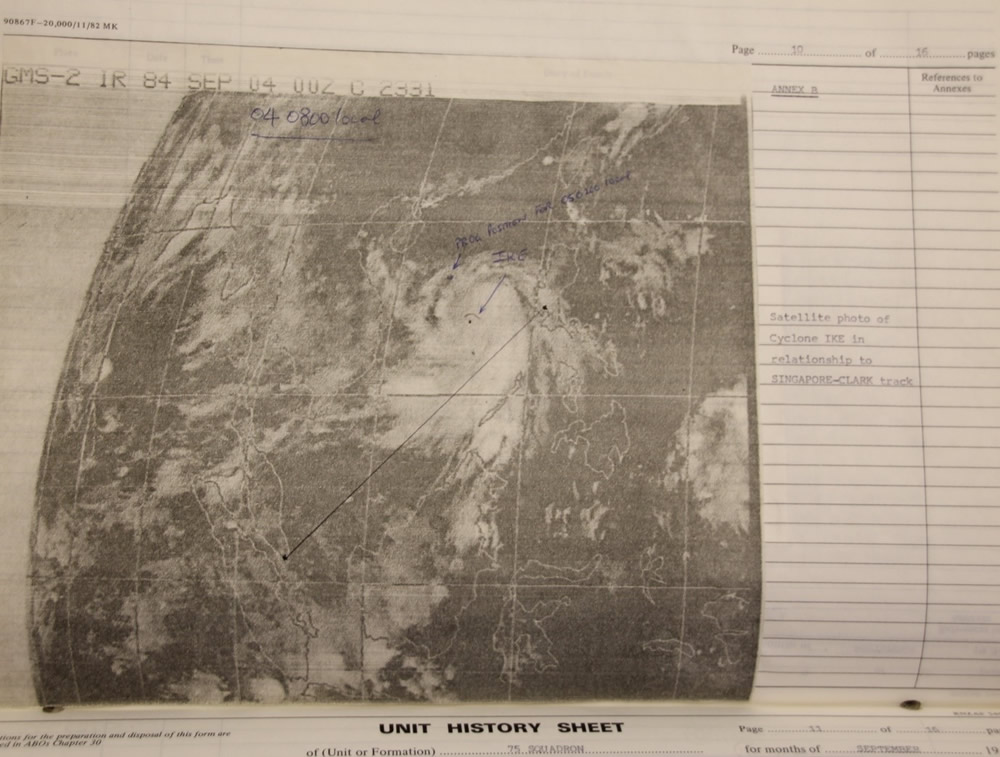
Deployment from Singapore to the Philippines
On Wednesday 5 Sep 84, as CO 75 Sqn, I was also the Deployment Commander aboard the RNZAF P3B Orion NZ4204, captained by Sqn Ldr John Cotton, that provided enroute ‘comms and nav assistance’ for the eight 75 Sqn A4 Skyhawks flying from Paya Lebar to Clark AB – a distance of some 1280nm/2322km. On board the P3B a ‘Chips Detector light’ illuminated while we were flying the route signifying the presence of metal chips in the oil system of one engine – the P3 Skipper simply shut down that engine and we continued escorting the A4s to Clark AB.
There were two Skyhawk TA4Ks (NZ6252 and NZ6254) amongst the eight Skyhawks on this deployment. As the TA4K carried 1000 pounds less fuel than the single-seat A4K (which equates to about 30 minutes flying time at some 30,000 feet nearing the end of a 3 hour flight), we had asked the RSAF if they could provide a ‘top-up’ air-to-air refuelling for our two TA4Ks.
At some time earlier the RNZAF had lent an air-to-air ‘Buddy Store’ air refuelling underwing drop tank to the RSAF, and on enquiring if they could air-refuel our TA4Ks, they said the Buddy Store was ‘unserviceable’. So we got another Buddy Store positioned in Singapore in late August ’84 by one of the RNZAF C130s coming from New Zealand to take 75 Sqn support gear and personnel from Singapore to the Philippines.
Before Wednesday 5 Sep 84, an air-to-air refuelling sortie was flown with an RSAF A4-S as tanker carrying ‘our’ buddy store – this sortie served as a practice before the ‘real’ one on 5 Sep, and provided opportunity to ensure the respective pilots were happy with correct air refuelling procedures and techniques. Once airborne from Paya Lebar on 5 Sep 84 enroute to Philippines, hook-up with the RSAF A4-S tanker was accomplished, fuel transfer worked as planned, and all eight 75 Sqn A4s positioned safely at Clark AB. A fine example of international airforce cooperation.
The pilots who flew the A4Ks to the Philippines were as follows:-
Kiwi Red Sqn Ldr John Bates AFC NZ6201
Fg Off Trev Marsh NZ6203
Flt Lt Stu McKenzie NZ6204
Kiwi Gold Flt Lt Ian Walls NZ6209
Fg Off Dave Barham NZ6208
Fg Off Mark Tapp NZ6210
Kiwi Amber Flt Lt Mark Helliwell/Fg Off Nick Osborne NZ6254
Flt Lt Ross Drysdale/Flt Lt Dave Brown NZ6252
Aboard the P3B were Mission Commander Wg Cdr Jim Barclay, and ‘Natops Reader’ Fg Off Mark Wingrove.
An Advance Party of three 75 Sqn officers had positioned at Clark AB from Singapore before our arrival –they were 75 Sqn Op Flt Cdr Maj John Davis USAF, 75 Sqn Maintenance Flt Cdr Flt Lt Chris Torr, and Admin Flt Cdr Sqn Ldr Mike Bain.
The 14th, and last, A4 pilot, Fg Off John Benfell, had to ride in a Support C130H on his flight to Clark AB.
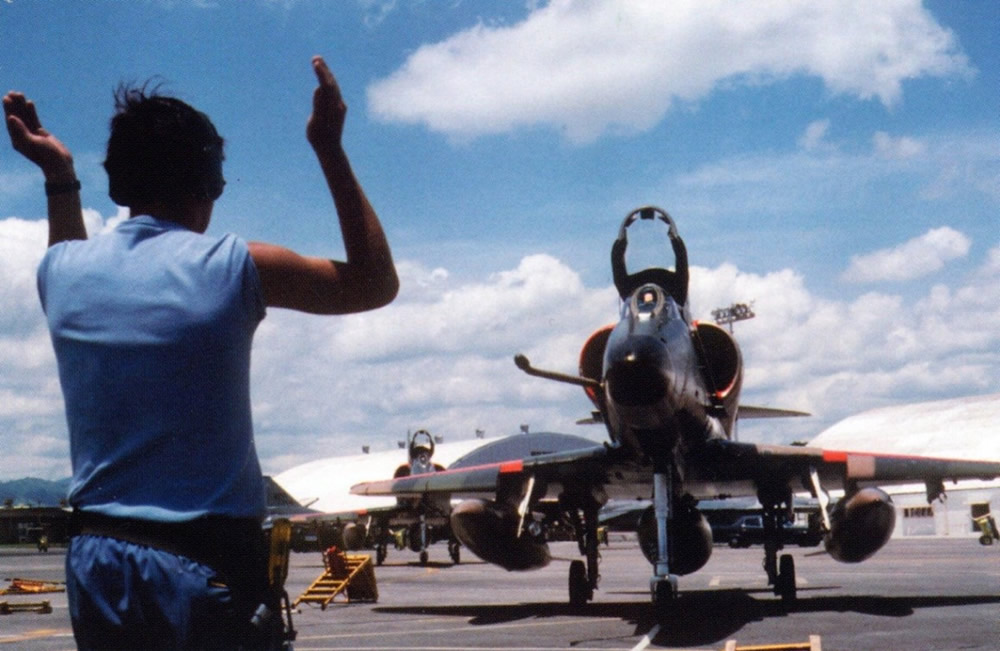
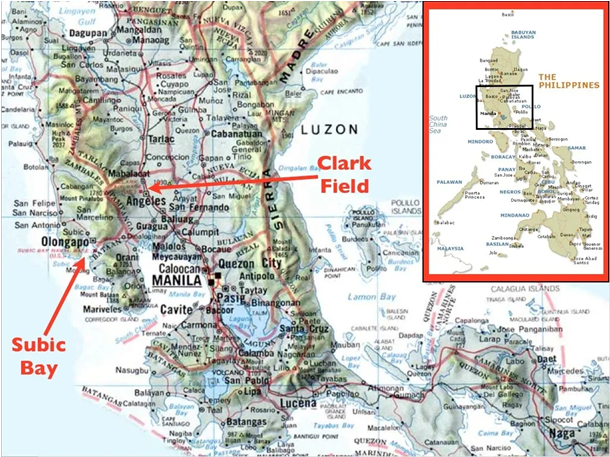
Thursday 6 Sep 84 – we spent the day doing routine tasks including a USAF ‘in briefing’ of Clark AB local flying rules and procedures, and blocked runway diversion procedures to NAS Cubi Point on Subic Bay, plus planning for an area ‘famil’ flight on 7th Sep. I also made courtesy calls on appropriate USAF and Philippine senior officers.
Friday 7 Sep 84 – I flew A4K NZ6210 for 1.2 hours, as #1 of 2, on a local area Navex, followed by ‘famil’ touch-and-go landings at both Clark AB and NAS Cubi Point – my ‘wingman’ for our time in the Philippines was Fg Off Nick Osborne.
Ex Cope Thunder
The 3-hour USAF ‘In-Briefing’ held on Saturday 8 Sep 84 for Ex Cope Thunder 84-7 involved all aircrew destined to fly in the exercise over the following two weeks. As with normal protocol, the briefing started with a welcome from the USAF Commanding General before detailed briefings were given to cover the scope and conduct of the Exercise, and flight safety rules.
Analysis of fighter combat operations in WW2, Korea, and Vietnam showed that if a ‘novice’ pilot could survive the first 10 combat missions, they had an even chance of survival. This led to the founding of a number of advanced air exercises, the purpose of which was to introduce and expose pilots to high intensity operations; hence the establishment of exercises such as Red Flag and Green Flag at Nellis AFB Nevada, Maple Flag at Cold Lake AFB Canada, and Cope Thunder at Clark AB Philippines. Additionally, very demanding high yield courses were set up for selected aircrew including the USAF Fighter Weapons School at Nellis AFB, and the then USN ‘Top Gun’ course at NAS Miramar, San Diego. All these were supplemented by increasing use of air combat training in flight simulators with pilots flying in opposing cockpits against another ‘adversary’- and amongst many sortie objectives pilots were required to use the correct cockpit ‘switchology’ to ensure the required radar or heat seeking missile, or the guns, were ‘fired’ in the simulator – and the simulator faithfully recorded for all to see if the wrong munitions were selected and fired.
The said exercises were scripted to ensure a staged and progressive learning process that built on knowledge and experience gained in each successive sortie – thus, a ‘crawl-walk-run’ approach, starting with small formations using basic principles and leading progressively to large multi-aircraft formations flying more complex missions, and radio communications jamming, by the end of the period of intense training.
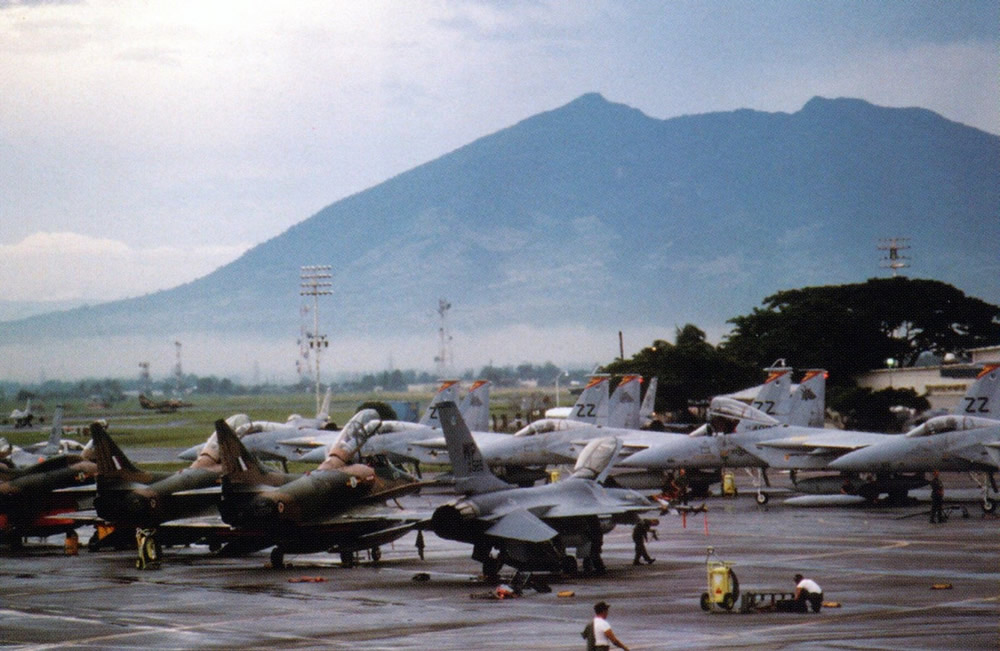
In the case of 75 Sqn’s involvement in Cope Thunder 84-7, we opted for missions that suited the capability of our Skyhawks, including Defensive Counter Air (DCA), Hunter Killer, Close Escort, Offensive Counter Air (OCA), and, Interdiction.
I was delighted to reunite at Clark AB with some of the USAF Instructor Pilots (IPs) and Instructor Weapons System Operators (IWSOs) who I had flown alongside in my earlier (1979-82) USAF exchange posting on the F4E and D Phantoms at Homestead AFB, Florida – these IPs and IWSOs were now based at Clark AB flying on the same Ex Cope Thunder 84-7 in their 3rd Tactical Fighter Sqn F4E aircraft.
While on my F4 exchange posting with the USAF, I had flown on the two-week long Ex Maple Flag held at Cold Lake AFB, Canada, so I was at least aware of the steep learning curve and demands that would be part of the Ex Cope Thunder process – and so I was able to brief and prepare 75 Sqn pilots accordingly, as well as maintaining close supervision of them in conjunction with my experienced squadron executives.
There were three ‘waves’ or flying sessions each day for Ex Cope Thunder; sessions began some hours before scheduled takeoff time when the Mission Commander for that session met with the crews scheduled to fly on that attack mission to discuss and agree on the scope of the mission and the broad tactics to be employed; after elements had completed their detailed mission planning, crews met again with the Mission Commander to agree on matters including in radio frequencies, timings, routes to be flown, targets, safety and emergency procedures. The ‘Red Air’, or opposing, Mission Commander followed a similar profile with crews of his participating interceptor aircraft. After the Mission, all participating crews met in open forum for a ‘full and frank’ discussion of the mission outcome, and most importantly, the ‘lessons learned’.
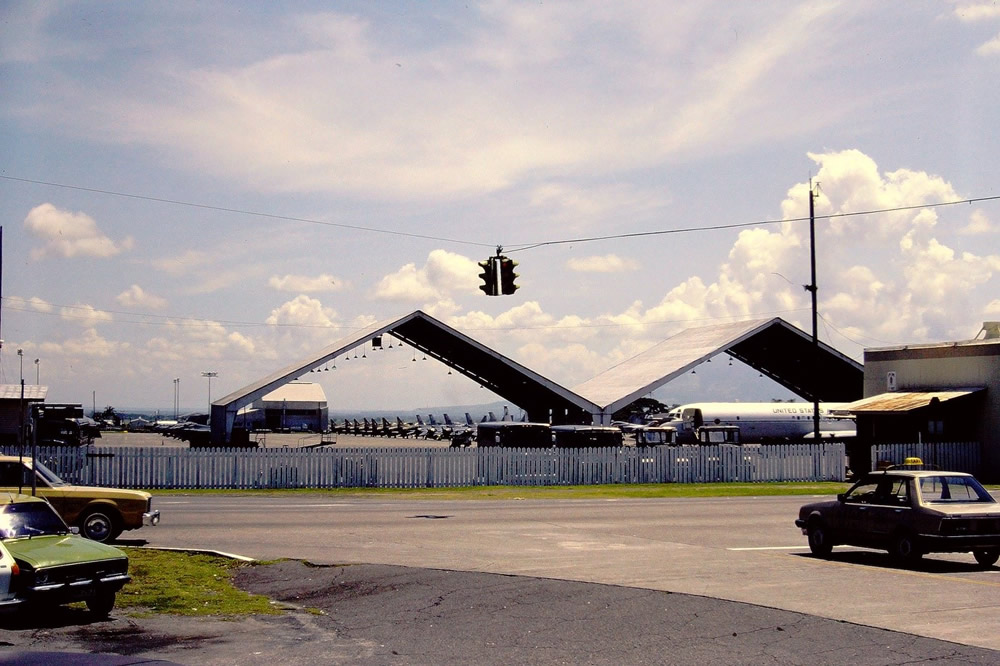
Saturday 8th and Sunday 9 Sep 84 – apart from the 3-hour Ex Cope Thunder ‘in-brief’ on Saturday 8 Sep 84, this was a weekend ‘at leisure’ with time to check out the local shops at nearby Angeles City (and Alongopo City near NAS Cubi Point) for ‘goodies’ to take home to our respective families.
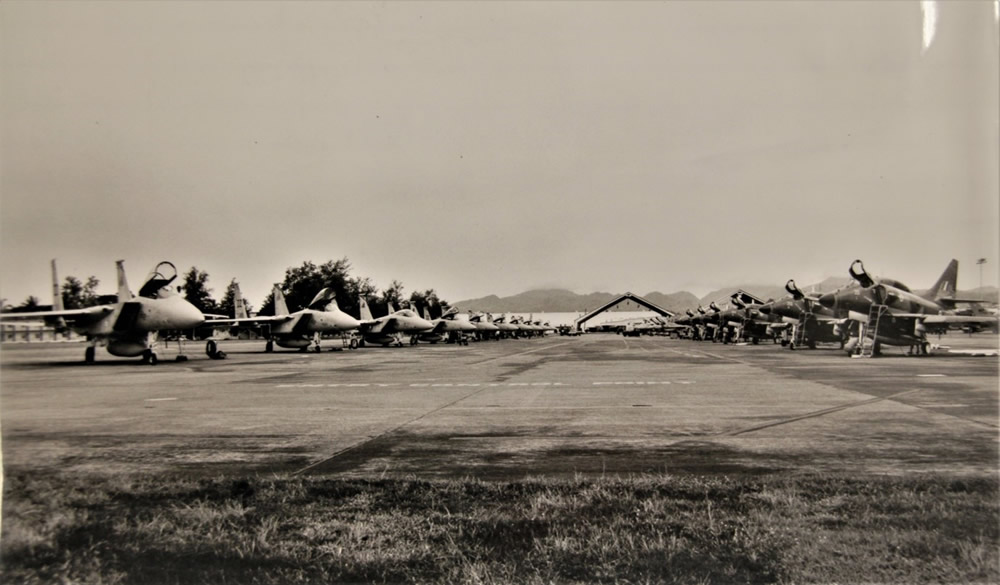
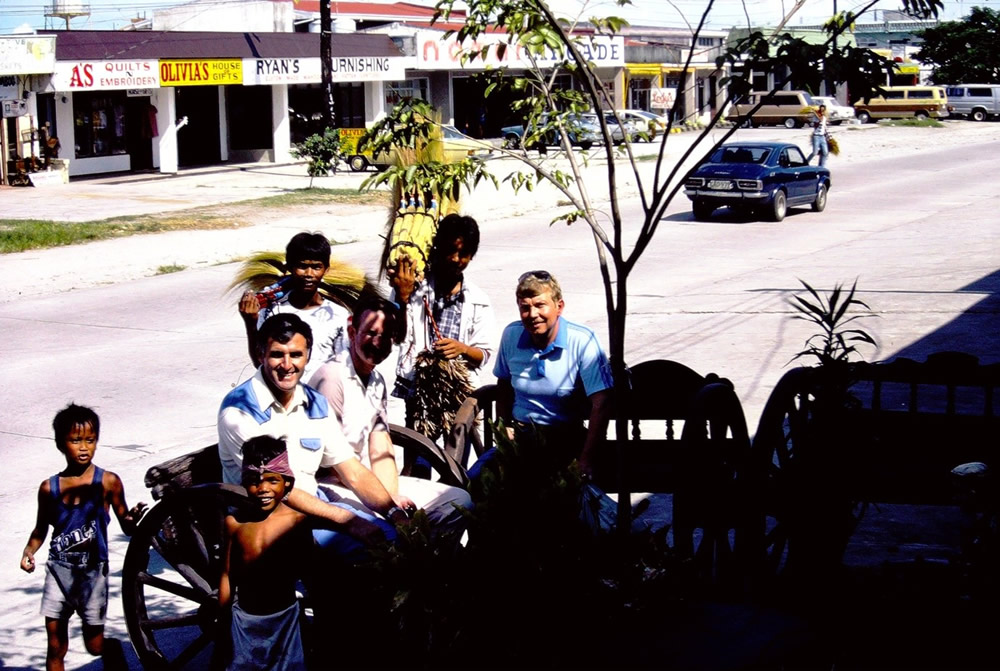
Monday 10 Sep 84 – I flew A4K NZ6201 for 1.1 hours, as 1 of 2, on a DCA sortie. This flight was amongst the first of Ex Cope Thunder 84-7. Apart from the bare details, my Pilots Logbook gives me no other information of what the sortie involved. I expect we were providing low level defensive cover against interceptor fighters for a small formation of attackers as they flew a pre-planned route to a target.
Tuesday 11 Sep 84 – I flew A4K NZ6210 for 1.0 hour, as 1 of 2, on a ‘hunter-killer’ sortie with two F4G Phantom ‘Wild Weasel’ aircraft; the targets were SAM sites in the Crow Valley weapons range, and we carried 4 x Mk82 500lb inert bombs to drop on the targets. I expect we would have flown a route to the target area in tactical spread formation in conjunction with the Wild Weasels, and we held clear of the target area while they located the actively emitting SAM sites. Once located, the Weasels passed target instructions to us including heading and time at a pre-determined speed from a designated Initial Point (IP). We would then have flown the required track towards the target at high speed (circa some 480 knots) at low level before dropping our bombs in a low altitude high-drag configuration; or we could have employed a dive attack by commencing a pull-up to some 45 degrees of climb until reaching a pre-planned pull-down altitude, and after ‘apexing’, dropping the bombs from a dive bomb profile, followed by a low level ‘jinking’ egress from the target area.
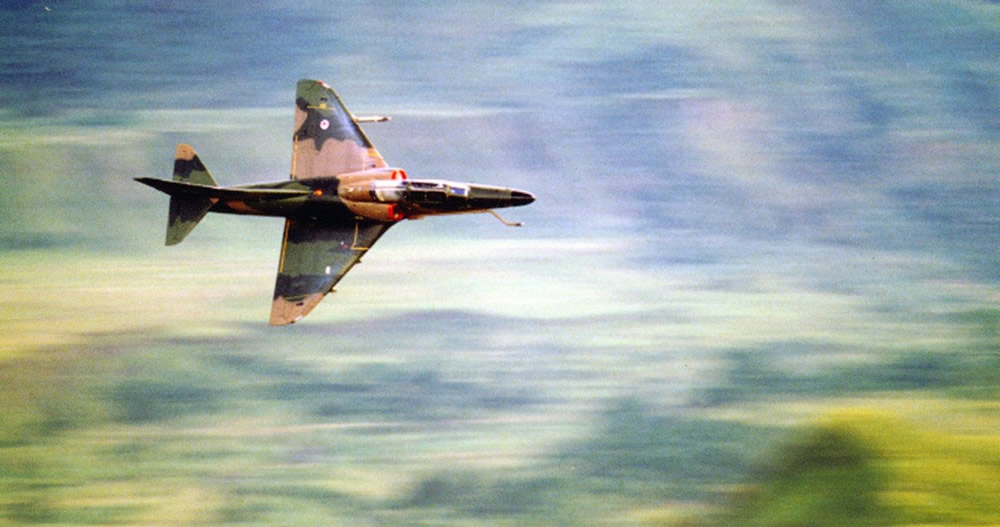
Wednesday 12 Sep 84 – I flew A4K NZ6201 for 1.4 hours, as 1 of 2, on a DCA sortie. There were plenty of other aircraft to intercept and ‘fight’ against including F15, F16, F4E, F4G, A7E and C130 aircraft.
Thursday 13 Sep 84 – I flew A4K NZ6201, as 1 of 2, for 1.0 hour on a DCA sortie, this time working with T33s, and USAF F5 ‘Aggressors’.
Friday 14 Sep 84 – I flew A4K NZ6203, as 1 of 4, for 1.3 hours on a DCA close escort sortie for a camouflaged C130 flying a route leading to a low level supply drop. It was quite a challenge keeping the speed up in the A4K while weaving behind the slower C130, all the time keeping a good lookout for fellow A4s and any attacking ‘bandits’.
NZ Government’s anti-nuclear announcement – In 1984, New Zealand passed legislation that made the entire country a nuclear-free zone, which effectively barred American warships from docking in New Zealand ports. Consequently, the US froze New Zealand out of the ANZUS military alliance and downgraded their diplomatic status from that of a close ally to a friend.
75 Sqn was nearly midway through Ex Cope Thunder when newly elected NZ Prime Minister David Lange made the aforementioned announcement. From that point on, our US hosts adopted a ‘polite but cool attitude’ to we Kiwis – formal evening functions for me as well as a pre-planned weekend round of golf with the General were cancelled. Although our further involvement in Ex Cope Thunder remained totally professional in every respect, and cordial relations amongst pilots were maintained in the bar, some other functions were shelved.
Saturday 15th & Sunday 16 Sep 84 – weekend time ‘at Leisure’. I remember we were invited to a USAF pilot’s house for a BBQ. When we asked why a dog was tied up in his back yard and he said “Oh that’s the BBQ” – we left.
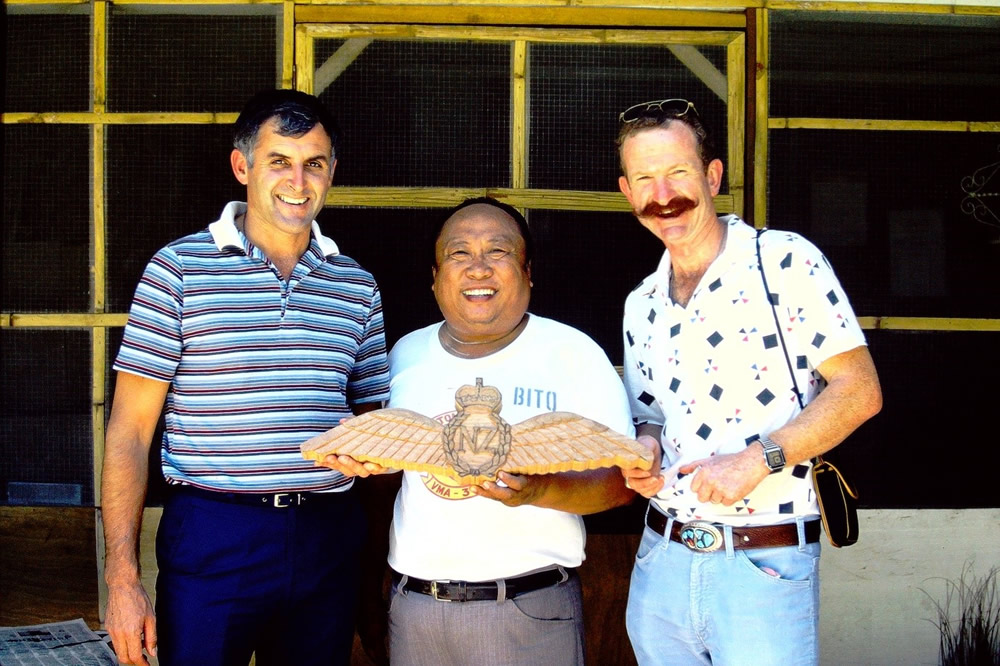
Monday 17 Sep 84 – I flew A4K NZ6209, as 1 of 2, for 1.0 hour on an Offensive Counter Air (OCA) sortie; we escorted a USAF Phantom RF4 recce aircraft to its target, then escorted USN A7E ‘Strikers’ to their target while two F15s tried to intercept them – and here we claimed gun ‘kills’ on two USAF 15 aircraft. I remember this sortie for the lessons it taught the F15 pilots. My wingman (Fg Off Nick Osborne) and I were at low level when I saw two F15s approaching at a about 8,000 feet agl. To my surprise they made an ‘in place’ 180 degree turn, which meant neither F15 pilot could check the other aircraft’s 6 o’clock during the turn – which is where we came from. Judging the optimum moment, we zoomed up from low level into their ‘6 o’clock’ to claim a 20mm gun kill on both of them. Having gunned them, we sat in close formation on their wingtips and saw that the pilots were still ‘head-down’ looking for us in their radar scopes. I transmitted a “yoo hoo” on 243.0 UHF Guard frequency, whereupon my F15 pilot looked up and saw me: Game Over!
At the later post-flight mass debrief for the exercise flying that day it was confirmed by both F15 pilots themselves that they were ‘head-in cockpit’ looking at their respective radar scopes, they did an in-place 180 deg turn instead of a tactical 180 wherein they could ‘check-six’ during the turn, and that they never did look out of their canopies until it was too late. I made the point that pilots who don’t follow simple procedures, in particular to get their eyes out of the cockpit at the ‘merge’, could well have an unsophisticated aircraft like an A4 Skyhawk down a mighty F15 air interceptor. The Commanding General agreed with me! And such is an example to the value of exercises such as Cope Thunder.
Tuesday 18 Sep 84 – I flew A4K NZ6208, as 3 of 4, for 1.2 hours on an interdiction attack sortie to bomb targets in Crow Valley range with 4 x inert Mk82 500lb bombs, while we in turn were escorted by USAF F16s. This was a much more complex mission than those from early in the preceding week and involved many more aircraft flying a wider range of roles. 75 Sqn was now approaching the ‘run’ stage of the ‘crawl-walk-run’ analogy. Air Commodore Geoff Hubbard OBE, AOC RNZAF Operations Group, arrived from New Zealand at Clark AB in a RNZAF C130H Hercules flown by Flt Lt John Marrett.
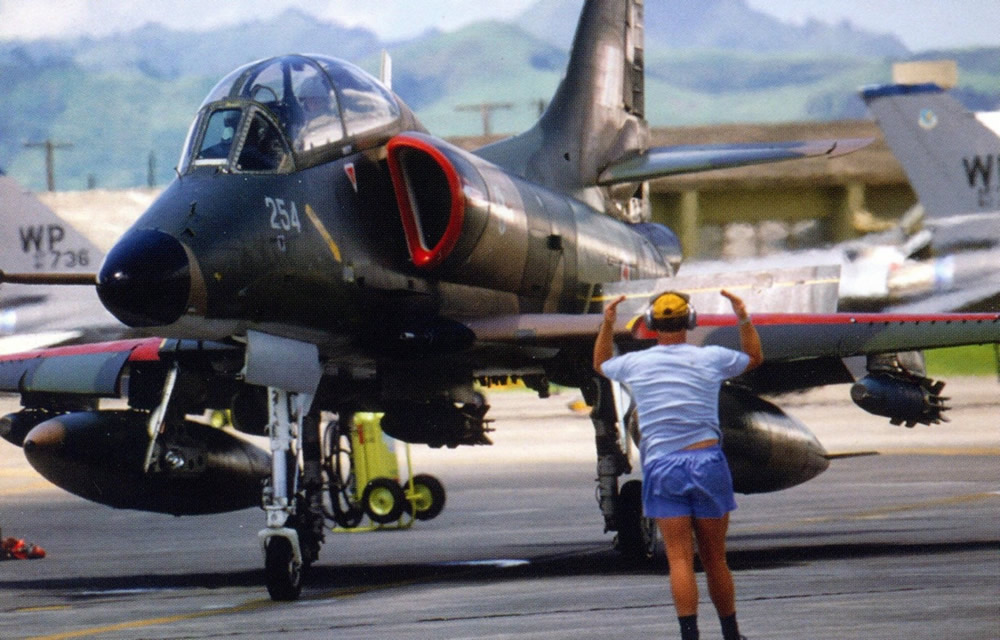
Wednesday 19 Sep 84– I flew TA4K NZ6254 on a 1.0 hour DCA sortie, as 1 of 2. My passenger was Air Commodore Geoff Hubbard and in order that he gained a full appreciation of the demands and challenges facing a 75 Sqn pilot at Ex Cope Thunder, I involved him in all aspects of the flight – ranging from the time the ‘Frag’ (tasking order) was received, through flight planning, mission brief, conduct of the flight, to the lengthy debrief and lessons learned.
Thursday 20 Sep 84 – I flew NZ6201 for a 1.0 hour Interdiction sortie, as 1 of 2, to attack pre-planned targets on Crow Valley range from a ‘pop-up’ ingress and egress profile carrying and dropping 4 Mk 82 500lb inert bombs. This was my final Ex Cope Thunder mission.

Friday 21 Sep 84 – I had no flying today on this the last day of Ex Cope Thunder 84-7. We had the final ‘out-briefings’ with our USAF hosts to ‘wind up’ our involvement in Ex Cope Thunder 84-7.
The value of the Ex Cope Thunder
We planned and flew six of our eight aircraft in two of the three daily ‘waves’ of the exercise, and such was the excellent preparation and reliability of our aircraft, we achieved 100% of our planned 116 sorties. At the final ‘out-brief’ we earned a special accolade from the USAF who warmly complimented 75 Sqn for the significant serviceability achievement that evidently had not happened for some time. Our groundcrew and support staff deserved all the praise I could give them.
Over the period of the exercise our pilots learned considerable new skills while operating with and against a wide variety of dissimilar combat capable aircraft – all this in a number of different roles for which the diminutive A4 Skyhawk was able to be employed. Flight safety was always ‘paramount’ in all of the exercise flight operations, and we had no incidents or accidents while flying in a very demanding and realistic ‘semi-combat’ environment. Our pilots adapted quickly day-on-day to new and increasingly challenging demands; we all learned a great deal from the ten Cope Thunder sorties that each of the fourteen 75 Sqn pilots achieved. Was it value for money? – absolutely.
Saturday 22 Sep 84 – This was to be our final day in the Philippines, we thought. We completed packing up and loading the support C130s. I held a re-deployment briefing to cover the flights and operations from Clark AB to RNZAF Ohakea that involved the A4 Skyhawk, P3B Orion, and C130H Hercules aircrew, plus some of our groundcrew.
Redeployment of 75 Sqn to New Zealand
Sunday 23 Sep 84 – We all had an early 0430 hours start to flight plan and brief so as to make a 0630 departure from Clark AB. But, on start-up, the AJB3A All Attitude Indicator (we called it the Abba-Jabba) failed in my A4K NZ6201. As this was the primary flight instrument giving pitch, roll and heading indications, I could not proceed on the flight without it. Accordingly, I shut down the engine in NZ6201, but as no ‘quick fix’ was possible I directed all other Skyhawks to shut down, as well as our escort P3B Orion. With a very long day head in order to fly to Biak, then on to Townsville, and having already lost considerable time while our ground crew tried to fix NZ6201, I made the decision in conjunction with the Deployment Commander aboard the P3B to delay by 24 hours our departure from Clark AB.
Monday 24 Sep 84 – Leg 1 – Another 0430 hours briefing time in order to be airborne by 0630 hours, which we achieved. I flew A4K NZ6203 (I didn’t trust NZ6201!) from Clark AB to Biak, Indonesia, in 3.5 hours, a distance of some 1294nm/2397km; I was #1 of 3 aircraft, and leader of all 8 Skyhawks flying in two 3-aircraft formations, plus a 2-aircraft formation that included the two TA4Ks. Flight callsigns, pilots and aircraft were as follows:
Kiwi Red Wg Cdr Jim Barclay NZ6203
Fg Off Trev March NZ6201
Flt Lt Ross Drysdale NZ6204
Kiwi Gold Sqn Ldr John Bates AFC NZ6208
Fg Off Nick Osborne NZ6209
Flt Lt Ian Walls NZ6210
Kiwi Amber Maj John Davis USAF/Fg Off Mark Wingrove NZ6254
Fg Off John Benfell/Fg Off Dave Barham NZ6252
Aboard the P3B with the Deployment Commander were two A4 pilots as ‘Natops readers’ – Flt Lt Stu McKenzie and Flt Lt Mark Helliwell. Travelling as passengers aboard the Support C130s were A4 pilots Flt Lt Dave Brown and Fg Off Mark Tapp.
Soon after departure from Clark AB, our two TA4Ks were air-to-air refuelled by a USN A7E Corsair II aircraft of VA105 that was based at NAS Cubi Point. A RNZAF P3B Orion accompanied the Skyhawks giving enroute ‘comms and nav’ assistance, and SAR should the need arise. The three Support C130H Hercules aircraft provided transport for personnel and support equipment. A RNZAF Andover had pre-positioned the RNZAF’s mobile TACAN at Biak before our arrival.

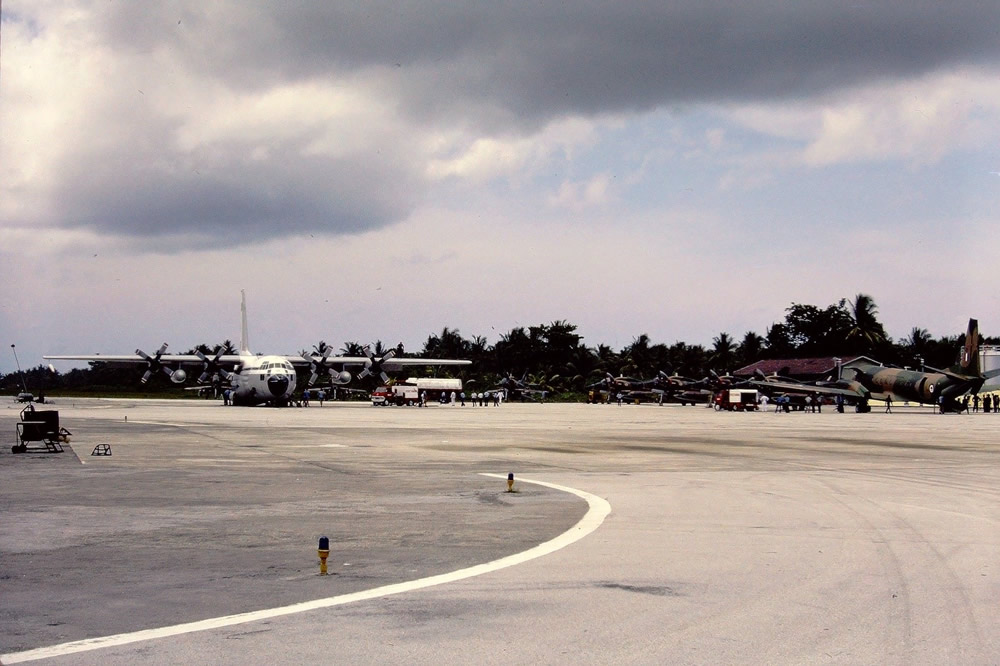
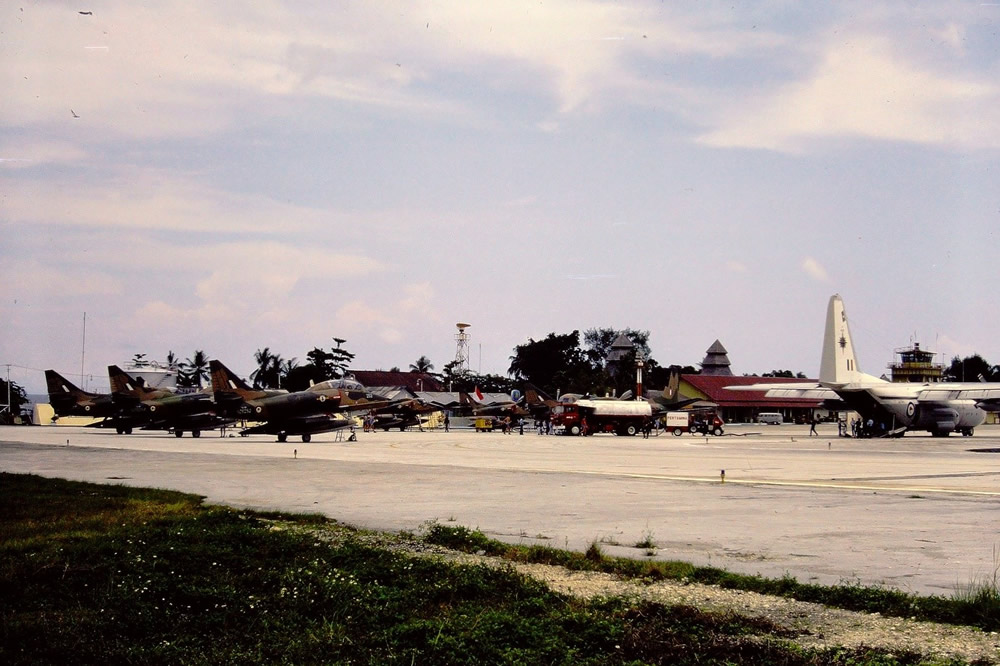
Leg 2 – after refuelling at Biak I flew NZ6203 again, this time for 3.1 hours, as #1 of 3, from Biak to RAAF Townsville, a distance of some 1250nm/2345km – a long leg for the two TA4Ks.
Tuesday 25 Sep 84
Leg 3 – After an overnight stay in Townsville, I flew NZ6203 from RAAF Townsville to RAAF Amberley, a distance of some 593nm/1100km, for 1.3 hours, as 1 of 3 (1 of 8)
Leg 4 – After a refuel, flight planning, and donning the pilot’s immersion suit, I flew NZ6203 from RAAF Amberley to Ohakea, a distance of 1350nm/2500km, in 3.2 hours, as 1 of 3 (1 of 8).
On this leg a potential problem brewed in TA4K NZ6252 flown by Fg Off John Benfell, with Fg Off Dave Barham in the rear seat: fuel failed to feed from one of the two 300 gallon underwing drop tanks leaving the TA4K with some 2000 lb of trapped and unusable fuel. Although the TA4K could have diverted to land at New Plymouth airport, stress mounted as Fg Off John Benfell completed a rendezvous directed by Ohakea Air Traffic Control before air-to-air refuelling from A4K NZ6205 flown by Ohakea Base Commander, Gp Capt Stewart Boys AFC. It proved to be a wise decision to have NZ6205 airborne from Ohakea and ready to meet and transfer fuel to the arriving TA4s, should the need arise.
Summary
75 Sqn was away overseas from Ohakea for 44 days; we travelled some 5216nm/9660km getting to Singapore in 12.3 A4 flying hours, a further 1280nm/2322 to Clark AB in 3.2 hours, and 4487nm/8309km in 11.1 hours to get home again. All in, a total of some 10983nm/20340km in 23.5 flying hours for a single A4 aircraft, or about 188 transit hours for all eight A4s. Add in the in-theatre hours flown by each of the eight A4s and one could see we flew a lot of hours on the deployment.
With around 120 personnel comprising regular 75 Sqn members and additional specialist ‘loan-back’ personnel, we participated successfully in two major air exercises in foreign lands – and all 14 Skyhawk pilots attested to the very high value of air combat training we got through participation in Ex Cope Thunder.
To get us to our respective theatres of operations, and safely home again, we were very ably supported by crews of No 5 Squadron’s P3B Orions and No 40 Squadron’s C130H Hercules; and we had in-theatre support by the crew of a No 1 Squadron Andover who positioned the mobile TACAN at both Bali and Biak.
The outstanding results achieved by all were true testament to the RNZAF working well together in order to achieve a common goal. That the whole deployment went virtually without a hitch is testament to the skilled planning and professionalism of all members of the RNZAF.
In late 1984 the Chief of Air Staff, AVM David Crooks CB OBE, used Fg Off Dave Barham’s words written for the 75 Unit History of September 1984: – “It is considered to be a credit to the RNZAF that 14 pilots could take eight aircraft with relatively unsophisticated nav/attack systems some 4000 miles and compete credibly against some of the most expensive and advanced aircraft in the world. The flexibility displayed by our pilots in changing between roles in a forever changing environment proved the value of RNZAF training. Then to achieve the highest serviceability rate and equal, if not better, the results of the Americans in the air is something to be proud of.” – source-75 Sqn Unit History Sep 84, and, ‘Skyhawks: The History of the RNZAF Skyhawk’ by Don Simms/Nick Lee-Frampton, pg 117
And only two days after 75 Sqn arrived home, RAAF and USAF military aircraft began arriving in New Zealand in preparation for the biggest air exercise to be held on our shores – ‘ANZUS Ex Triad New Zealand 1984’ from 5th until 9th Oct 84.
All this operational activity in Vanguard 84, Cope Thunder 84-7, and Triad 84 bore true testament to the 75 Sqn moto ‘Ake Ake Kia Kaha’ – translated to ‘Fight On For Ever And Ever’, or, ‘For Ever and Ever, Be Strong’.
Air Cdre J. S. (Jim) Barclay AFC RNZAF (Rtd), April 2024
[CO 75 (A4 Skyhawk) Sqn, Dec 83-Nov 85]


Sam Fulton
Posted at 08:20h, 12 OctoberHi Jim, I really enjoyed reading this and seeing all the photos from that deployment. I just hope one day the RNZAF gets its strike wing back, exercises like this prove that we need a credible and well trained group of pilots and aircraft, even more so in todays benign environment. Regards, Sam.
Jim Barclay
Posted at 09:31h, 23 OctoberThanks Sam. Don’t hold your breath about getting Strike Wing back again!! Back then e ere so lucky flying jets – and we got paid to do something so enjoyable!!
Cheers,
Jim